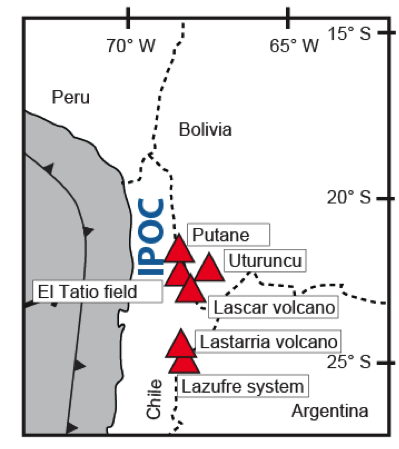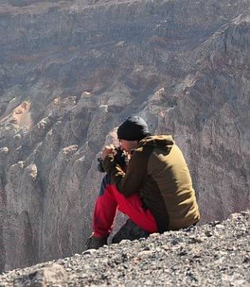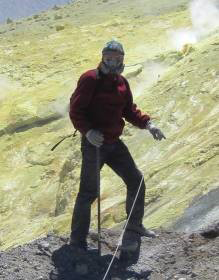Volcanoes at IPOC
Volcanoes in the IPOC region are investigated with the aim to better understand the interaction of magmatic and hydrothermal activities with the environment. Especially the interaction of volcanoes and earthquakes, and fluid migration in the crust are in the scientific focus of the volcano observations in IPOC. To this aim we monitor deformation associated with magma intrusions, cooling and loading, we measure surface and fumarole temperatures, we record the seismicity and perform dedicated experiments.
Monitored volcanoes
Specifically, the following volcano sites are being monitored:

Measurement types
Monitoring includes, but is not limited to:
- Seismology networks
- Time lapse camera of degassing
- Temperature at fumaroles and hot pots
- Deformation from InSAR and GPS
- Topography from LiDAR and SfM
- Infrared from handheld and drones
- Weather from meteorological station
Data
Teporary seismological networks of Lastarria and Lascar volcanoes are archived in the GFZ Seismological Data Archive (GEOFON) with the network codes 2G (Latarria, http://doi.org/10.14470/7T7561754109) and 8E (Lascar, http://doi.org/10.14470/3R7569753098).
Terrestrial laser scanner data covering the summit craters of Láscar Volcano is available via http://doi.org/10.5880/GFZ.2.1.2016.002 (Richter et al., 2016).
A full overview on all available datasets of IPOC is given in the Data section.
Partners and People
People involved: Thomas R. Walter, Martin Zimmer, Christian Kujawa, Jackie Salzer, Ayleen Gaete, Mehdi Nikkhoo
Partner institutions: GFZ German Research Centre for Geoscience, OVDAS, Sernageomin, Universidad Católica del Norte, GEOMAR Kiel
Selected Publications
De Zeeuw-van Dalfsen, E., Richter, N., González, G., & Walter, T. R. (2017). Geomorphology and structural development of the nested summit crater of Láscar Volcano studied with Terrestrial Laser Scanner data and analogue modelling. Journal of Volcanology and Geothermal Research, 329, 1–12. http://doi.org/10.1016/j.jvolgeores.2016.09.018
Ruch J, Walter TR (2010) The relationship between current uplift geometry revealed by InSAR, structural framework, and the present-day stress field at Lazufre volcanic area, central Andes. Tectonophysics, 492, http://doi.org/133–140 doi:10.1016/j.tecto.2010.06.003
Ruch J, A Manconi, G Zeni, G Solaro, A Pepe, M Shirzaei, T R Walter, R Lanari (2009) Stress transfer in the Lazufre volcanic area, central Andes, Geophys. Res. Lett., 36, L22303, http://doi.org/10.1029/2009GL041276
Ruch J, Anderssohn J, Walter TR, Motagh M (2008) Caldera-scale inflation of the Lazufre volcanic area, South America, evidenced by InSAR. Journal of Volcanology and Geothermal Research, 174 (4), 337-344, http://doi.org/10.1016/j.jvolgeores.2008.03.009
Spica Z, Legrand D, Iglesias A, Walter TR, Heimann S, Dahm T, Froger J-L, Rémy D, Bonvalot S, West M, Pardo M (2015) Hydrothermal and magmatic reservoirs at Lazufre volcanic area, revealed by a high-resolution seismic noise tomography. Earth and Planetary Science Letters 421, 27–38. http://doi.org/10.1016/j.epsl.2015.03.042
Walter TR, Ruch J, Manconi A, Shirzaei M, Motagh M, Anderssohn J (2011) Doming of Lazufre (in German: Die "Beule" von Lazufre). System Erde, 1,1, http://doi.org/10.2312/GFZ.syserde.01.01.5
Zimmer, M., T. R. Walter, C. Kujawa, A. Gaete, and L. Franco-Marin (2017), Thermal and gas dynamic investigations at Lastarria volcano, Northern Chile. The influence of precipitation and atmospheric pressure on the fumarole temperature and the gas velocity, Journal of Volcanology and Geothermal Research, doi.org/10.1016/j.jvolgeores.2017.03.013






